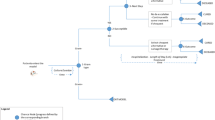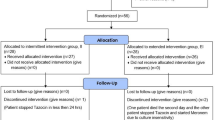Abstract
Objective: To compare the cost effectiveness of sequential intravenous (IV) to oral ciprofloxacin plus metronidazole (CIP/MTZ IV/PO) with that of IV ciprofloxacin plus IV metronidazole (CIP/MTZ IV) and IV imipenem-cilastatin (IMI IV) in patients with intra-abdominal infections.
Design and participants: Patients enrolled in a double-blind randomised clinical trial were eligible for inclusion into this cost-effectiveness analysis. Decision analysis was used to characterise the economic outcomes between groups and provide a structure upon which to base the sensitivity analyses. 1996 cost values were used throughout.
Setting: The economic perspective of the analysis was that of a hospital provider.
Main outcome measures and results: Among 446 economically evaluable patients, 176 could be switched from IV to oral administration. The 51 patients randomised to CIP/MTZ IV/PO who received active oral therapy had a success rate of 98%, mean duration of therapy of 9.1 days and mean cost of $US7678. There were 125 patients randomised to either CIP/MTZ IV or IMI IV who received oral placebo while continuing on active IV antibacterials; their success rate was 94%, mean duration of therapy was 10.1 days and mean cost was $US8774 (p = 0.029 vs CIP/MTZ IV/PO). Of the 270 patients who were unable to receive oral administration, 97 received IMI IV and had a success rate of 75%, mean duration of therapy of 13.8 days and a mean cost of $US12 418, and 173 received CIP/MTZ IV and had a success rate of 77%, mean duration of therapy of 13.4 days and mean cost of $US12 219 (p = 0.26 vs IMI IV).
Conclusions: In patients able to receive oral therapy, sequential IV to oral treatment with ciprofloxacin plus metronidazole was cost effective compared with full IV courses of ciprofloxacin plus metronidazole or imipenem-cilastatin. In patients unable to receive oral therapy, no difference in mean cost was found between IV imipenem-cilastatin or IV ciprofloxacin plus IV metronidazole.
Similar content being viewed by others
References
Solomkin JS, Reinhart HH, Dellinger EP, et al. Results of a randomized trial comparing sequential intravenous/oral treatment with ciprofloxacin plus metronidazole to imipenem/cilastatin for intra-abdominal infections. Ann Surg 1996; 223: 303–15
Nichols RL, Smith JW. Wound and intra-abdominal infections: microbiological considerations and approaches to treatment. Clin Infect Dis 1993; 16 Suppl. 4: S266-S272
Drusano GI, Warren WJ, Saah AJ, et al. A prospective randomized controlled trial of cefoxitin versus clindamycin-aminoglycoside in mixed aerobic-anaerobic infections. Surg Gynecol Obstet 1982; 154: 715–20
Najem AZ, Kaminsli CR, Spiller CR, et al. Comparative study of parenteral pipericillin and cefoxitin in the treatment of surgical infections of the abdomen. Surgery 1983; 157: 423–5
Schentag JJ, Wells PB, Reitberg DP, et al. A randomized clinical trial of moxalactam alone versus tobramycin plus clindamycin in abdominal sepsis. Ann Surg 1983; 198: 35–41
Walker AP, Nichols RL, Wilson RF, et al. Efficacy of a betalactamase inhibitor combination for serious intra-abdominal infections. Ann Surg 1993; 217: 115–21
Solomkin JS, Fant WK, Rivera JO, et al. Randomized trial of imipenem-cilastatin versus gentamicin and clindamycin inmixed flora infections. Am J Med 1985; 78 Suppl. 6A: 85–91
Solomkin JS, Dellinger EP, Christou NV, et al. Results of a multicenter trial comparing imipenem-cilastatin to tobramycin-clindamycin for intra-abdominal infections.Ann Surg 1990; 212: 581–91
Hackford AW, Talley FP, Reinhold RB, et al. Prospective study comparing imipenem-cilastatin with clindamycin and gentamicin for the treatment of serious surgical infections. Arch Surg 1988; 123: 322–6
Uhari M, Seppanen J, Heikinen E. Imipenem-cilastatin versus tobramycin and metronidazole for appendicitis-related infection. Pediatr Infect Dis J 1992; 11: 445–50
Ho JL, Barza M. Role of aminoglycoside antibiotics in the treatment of intra-abdominal infection. Antimicrob Agents Chemother 1987; 31: 485–91
Whiting JI, Cheng N, Chow AW. Interactions of ciprofloxacin with clindamycin, metronidazole, cefoxitin, cefotaxime, and mezlocillin against gram-positive and gram-negative anaerobic bacteria. Antimicrob Agents Chemother 1987; 31: 1379–82
Brook I. In vivo efficacies of quinolones and clindamycin for treatment of infections with Bacteroides fragilis and/or Escherichia coli in mice: correlation with in vitro susceptibilities. Antimicrob Agents Chemother 1993; 37: 997–1000
Friedrich LV, White RL, Kays MB, et al. Pharmacoeconomic evaluation of treatment of penetrating abdominal trauma. Am J Hosp Pharm 1992; 49: 590–4
Gorbach SL. Treatment of intra-abdominal infections. J Antimicrob Chemother 1993; 31 Suppl. 4: 67–78
DiPiro JT. Considerations for therapy of mixed infections: focus on intra-abdominal infections. Pharmacotherapy 1995; 15 (1 Pt 2): 15S-21S
Eisenberg JM, Koffer H, Glick HA, et al. What is the cost of nephrotoxicity associated with aminoglycosides? Ann Intern Med 1987; 107: 900–9
Paladino JA, Sperry HE, Backes JM, et al. Clinical and economic evaluation of oral ciprofloxacin after an abbreviated course of intravenous antibiotics. Am J Med 1991; 91: 462–70
Lettieri JT, Rogge MC, Kaiser L, et al. Pharmacokinetic profiles of ciprofloxacin after single intravenous and oral doses. Antimicrob Agents Chemother 1992; 36: 993–6
Sanders JR. Efficacy, safety, and potential economic benefits of oral ciprofloxacin in the treatment of infections. Rev Infect Dis 1988; 10: 528–43
Höffken G, Lode H, Prinzing C, et al. Pharmacokinetics of ciprofloxacin after oral and parenteral administration. Antimicrob Agents Chemother 1985; 27: 375–9
Grasela TH, Paladino JA, Schentag JJ, et al. Clinical and economic impact of oral ciprofloxacin as follow-up to parenteral antibiotics. DICP Ann Pharmacother 1991; 25: 857–62
Powers T, Bingham DH. Clinical and economic effect of ciprofloxacin as an alternative to injectable antimicrobial therapy. Am J Hosp Pharm 1990; 47: 1781–4
Quintiliani R, Cooper BW, Briceland LL, et al. Economic impact of streamlining antibiotic administration. Am J Med 1987; 82 Suppl. 4A: 391–4
Paladino JA, Fell RE. Pharmacoeconomic analysis of cefmenoxime dual individualization in the treatment of nosocomial pneumonia. Ann Pharmacother 1994; 28: 384–9
Karlsson G, Johannesson, M. The decision rules of cost-effectiveness analysis. Pharmacoeconomics 1996; 9: 113–20
Udvarhelyi S, Colditz GA. Cost-effectiveness and cost-benefit analysis in the medical literature. Ann Intern Med 1992; 116: 238–44
Smith CF, Amen RJ. Comparison of seven methods of preparing and administering small-volume injections. Am J Hosp Pharm 1988; 45: 1896–901
Foran RM, Brett JL, Wulf PH. Evaluating the cost impact of intravenous antibiotic dosing frequencies. DICP Ann Pharmacother 1991; 25: 546–52
Tanner DJ. Cost containment of reconstituted parenteral antibiotics: personnel and supply costs associated with preparation, dispensing, and administration. Rev Infect Dis 1984; 6 Suppl. 4: S924-S937
Hatoum HT. Microcost analysis of inpatient dispensing and administration of oral solids. Am J Hosp Pharm 1990; 47: 800–5
The American Hospital Association. Hospital statistics: emerging trends in hospitals. Chicago (IL): American Hospital Association, 1995–96: 7
McKinnon PS, Paladino JA, Grayson ML, et al. Cost-effectiveness comparison of ampicillin/sulbactam versus imipenem/cilastatin in the treatment of limb-threatening foot infections in diabetic patients. Clin Infect Dis 1997; 24: 57–63
de Lissovoy G, Elixhauser A, Luce BR, et al. Cost analysis of imipenem-cilastatin versus clindamycin with tobramycin in the treatment of acute intra-abdominal infection. Pharmacoeconomics 1993; 4: 203–14
Paladino JA. Comparison of cefepime and ceftazidime using decision analysis. Pharmacoeconomics 1994; 5: 505–12
Thomas N. The role of pharmacoeconomics in disease management. Pharmacoeconomics 1996; 9 Suppl. 1: 9–15
Rifenburg RP, Paladino JA, Hanson SC, et al. Benchmark analysis of strategies hospitals use to control antimicrobial expenditures. Am J Health-Syst Pharm 1996; 53: 2054–62
Schentag JJ, Paladino JA, Birmingham MC, et al. Use of benchmarking techniques to justify the evolution of antibiotic management programs in healthcare systems. J Pharm Technol 1995; 11: 203–10
Bootman JL, Milne RJ. Costs, innovation and efficiency in anti-infective therapy. Pharmacoeconomics 1996; 9 Suppl. 1: 31–9
Geroulanos LO, Stern A, Christen D, et al. Antimicrobial management of postoperative infections in abdominal surgery: single or combination regimens? Clin Ther 1990; 12SB: 34–42
Poenaru D, DeSantis M, Christou NV. Imipenem versus tobramycin: antianaerobe antibiotic therapy in intra-abdominal infections. Can J Surg 1990; 33: 415–22
Gonzenbach HR, Simmen HP, Angwerd R. Imipenem (N-Fthienemycin) versus netilmicin plus clindamycin. Ann Surg 1987; 205: 271–5
Benfield P, Chrisp P. Imipenem/cilastatin: a pharmacoeconomic appraisal of its use in intra-abdominal infections. Pharmacoeconomics 1992; 1: 443–59
Jhee SS, Gill MA, Yellin AE, et al. Pharmacoeconomics of piperacillin/tazobactam and imipenem/cilastatin in the treatment of patients with intra-abdominal infections. Clin Ther 1995; 17: 126–35
Balfour JA, Bryson HM, Brogden RN. Imipenem/cilastatin: an update of its antibacterial activity, pharmacokinetics and therapeutic efficacy in the treatment of serious infections. Drugs 1996; 51: 99–136
Jensen KM, Paladino JA. Cost-effectiveness of abbreviating the duration of intravenous antibacterial therapy with oral fluoroquinolones. Pharmacoeconomics 1997; 11: 64–74
Eisenberg JM. Clinical economics. A guide to the economic analysis of clinical practices. JAMA 1989; 262: 2879–86
Detsky AS, Naglie IG. Aclinician’s guide to cost-effectiveness analysis. Ann Intern Med 1990; 113: 147–54
Siegel JE, Torrance GW, Russell LB, et al. Guidelines for pharmacoeconomic studies. Pharmacoeconomics 1997; 11: 159–68
Bulpitt CJ, Fletcher AE. Measuring costs and financial benefits in randomized controlled trials. Am Heart J 1990; 119: 766–71
Kolassa M, Smith MC, Banahan BF, et al. The effects of acquisition cost and budget-based compensation on the attitudes of pharmacy directors toward the adoption of a cost-effective new drug. Pharmacoeconomics 1998; 13: 223–30
Author information
Authors and Affiliations
Corresponding author
Rights and permissions
About this article
Cite this article
Walters, D.J., Solomkin, J.S. & Paladino, J.A. Cost Effectiveness of Ciprofloxacin plus Metronidazole versus Imipenem-Cilastatin in the Treatment of Intra-Abdominal Infections. Pharmacoeconomics 16, 551–561 (1999). https://doi.org/10.2165/00019053-199916050-00011
Published:
Issue Date:
DOI: https://doi.org/10.2165/00019053-199916050-00011




